Enhancing Efficiency with Stabilizer Hay Bale Spears
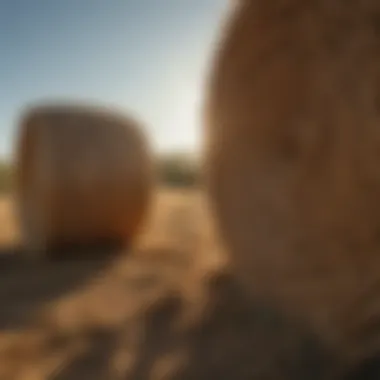
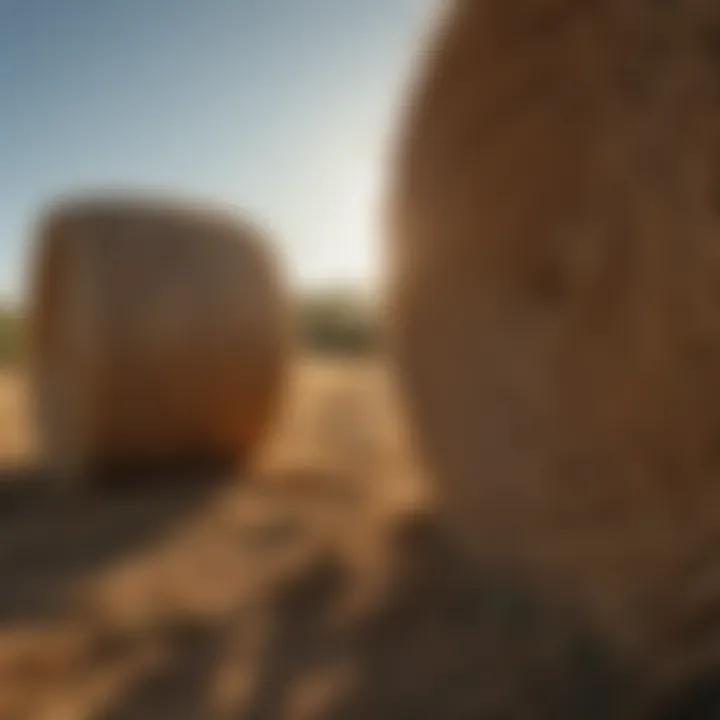
Intro
Stabilizer hay bale spears have become a crucial tool in modern agriculture, especially for those engaged in hay production and forage management. This implements are designed to simplify the process of handling bulky hay bales, improving efficiency and safety in operations. Understanding their design, functionality, significance, and the advancements made in recent years has become essential for both seasoned farmers and newcomers alike.
The role of these spears extends beyond mere convenience; they represent a blend of agricultural tradition and modern technology, fostering a more sustainable approach to farming. With the rising demand for efficiency in agricultural practices, the utilization of stabilizer hay bale spears can offer significant advantages in the day-to-day operations of farming. In the following sections, we will explore their definition, importance, historical evolution, innovations, and practical applications.
Prelude to Stabilizer Hay Bale Spears
In the fast-paced world of modern agriculture, efficiency stands as a hallmark of successful farming practices. Stabilizer hay bale spears have emerged as essential tools that facilitate this very efficiency. Farmers today face myriad challenges, ranging from labor shortages to the need for more streamlined equipment. This is where these specialized implements not only save time but also reduce physical strain on workers, making them invaluable to operations of all sizes.
Definition and Purpose
To put it plainly, stabilizer hay bale spears are designed to handle round bales of hay with ease. They are attached to tractors or loaders, allowing farmworkers to lift and move heavy bales from one point to another without much hassle. This is crucial, as bales can weigh anywhere from 500 to 2,000 pounds.
The primary purpose of these spears extends beyond mere transport—they promote proper hay storage and facilitate access for feeding livestock. By using stabilizer spears, farmers can maximize space during storage, reducing the risk of spoilage and increasing hay availability in times of need. The stability offered by these tools also minimizes the likelihood of dropping bales either during transport or stacking, preserving the integrity of both the bales and the machinery used.
Historical Context
The evolution of hay handling is a story in itself. Traditionally, farmers relied on manual methods, using pitchforks and simple hooks to manage hay bales. This approach required considerable labor and was fraught with inefficiencies. In the mid-twentieth century, the advent of mechanical equipment began to revolutionize the agricultural landscape.
With the growth of machinery, innovators started to develop specialized attachments to make farmers' lives easier. The stabilizer hay bale spear, specifically, entered the scene as a response to the increasing weight of modern bales and the need for more effective handling solutions. Over the years, advancements in materials and design have led to the modern iterations of these spears, which now boast enhanced durability and performance for various types of farming operations.
As we delve deeper into the specifics of stabilizer hay bale spears, it's crucial to appreciate their historical development and their role in shaping contemporary agricultural practices.
Design Features of Stabilizer Hay Bale Spears
When it comes to tackling the challenges of modern agriculture, the design features of stabilizer hay bale spears play a crucial role. Understanding these features can greatly enhance efficiency in hay handling and transportation. In the following sections, we’ll take a close look at the materials and construction, the various types of hay bale spears available, and important weight and balance considerations. Each facet reveals how these tools are not just mere accessories, but pivotal components in the farming toolkit.
Materials and Construction
The materials used in constructing hay bale spears are not just about durability; they directly affect performance and user safety. High-quality steel is commonly the go-to choice due to its ability to withstand significant stress. For instance, many spears are crafted from high-carbon steel, which offers excellent strength and resistance to bending or breaking under heavy loads. Additionally, surface treatments, such as powder coating, can protect against rust and corrosion, ensuring longevity even in harsh conditions.
The construction process is also vital. A well-engineered spear typically features a sharpened, tapered end for easy penetration into hay bales. This design not only increases efficiency when loading or unloading but reduces the effort needed from the operator. Overall, proper material selection and construction methods contribute significantly to operational success and safety.
Types of Spears Available
Standard Hay Bale Spears
Standard hay bale spears are often the first choice for many farmers due to their balance of strength and versatility. These implements usually feature a simple, straightforward design focused on handling regular-sized bales. A key characteristic is the spear’s length, which is designed to penetrate deep into bales with ease, making them a popular choice among those with conventional hay storage needs.
One unique feature of standard hay bale spears is their affordability; they are generally more cost-effective than specialized variants. However, they might struggle with extremely large bales, limiting their application in larger operations.
Heavy-Duty Options
For those who work with larger or denser hay bales, heavy-duty options present an outstanding choice. These spears are built using thicker steel and incorporate reinforced design elements to withstand added pressure without compromising their integrity. A key characteristic of heavy-duty spears is their added length and more robust tines, which effectively distribute weight and minimize the likelihood of bending.
Farmers often find these options beneficial for heavy-duty tasks, as they can handle difficult bales efficiently. The downside might be their heavier structure, which could require more power from lifting equipment and potentially make operation more strenuous.
Multi-Functional Designs
In today's agricultural landscape, flexibility often reigns supreme, and multi-functional designs are paving the way for that. These spears are not limited to just moving hay; they might include features allowing them to handle various materials or applications, such as loading pallets or silage. The versatility of these tools is their key characteristic, as they can adapt to various farming tasks, making them an invaluable asset for diverse operations.
A unique aspect of these models is the ability to quickly switch attachments for different tasks, optimizing productivity. Though they may come with a higher price tag, the investment can pay off by reducing the need for multiple individual tools. However, it’s essential to ensure that the functions do not compromise the spear's performance in any one application.
Weight and Balance Considerations
Weight and balance are critical factors that can greatly influence the efficiency and safety of hay handling. A well-balanced spear ensures easier maneuverability, reducing fatigue for the operator during prolonged usage. Ideally, when selecting a spear, farmers should consider the weight distribution; a spear that's too front-heavy can lead to control issues, while a well-balanced spear can enhance the precision of operation.
Moreover, the weight of the spear itself matters when paired with lifting equipment. If the spear is excessively heavy, it might necessitate more powerful machinery, thus impacting operational costs. Each farmer's specific needs will dictate the balance they require, but achieving the right weight can significantly increase both efficiency and user satisfaction.
Applications of Hay Bale Spears in Farming
Hay bale spears have become indispensable tools in modern agriculture, serving multiple crucial functions that streamline the process of hay handling. Their applications vary significantly and provide farm operatives with improved efficiency and effectiveness when working with hay bales. Ultimately, the right application of these spears can have a substantial impact on a farm's overall productivity and economic performance.
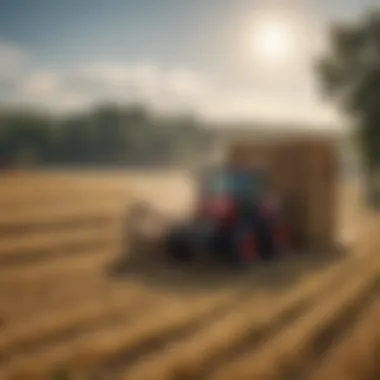
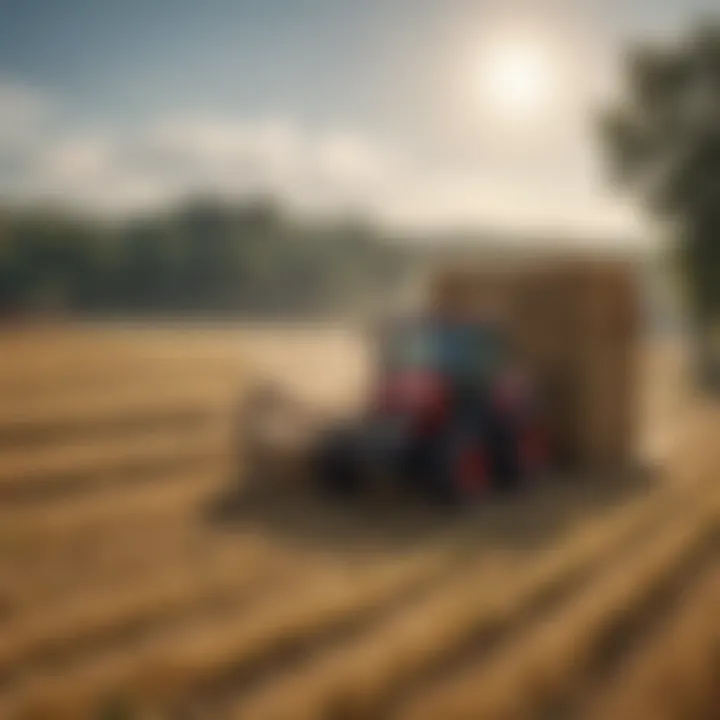
Loading and Unloading Bales
When it comes to loading and unloading hay bales, stabilizer hay bale spears shine exceptionally bright. These devices save farmers time and energy, transforming what used to be a labor-intensive chore into a much simpler task. By using a hay bale spear attached to a tractor or loader, individuals can pierce a bale without lifting it manually.
For instance, utilizing the spear allows one to handle large round bales with ease. The design allows the user to grip and transport multiple bales at once, minimizing trips and thus increasing the efficiency of hay movement on farms.
Key benefits include:
- Reduced Labor Costs: Less manual handling translates to lower labor expenses.
- Increased Speed: Moving hay bales quickly can alleviate scheduling pressures during busy harvest times.
- Safety Improvements: Less manual lifting reduces the risk of injury among farm workers.
Transporting Hay Bales
Transporting hay bales across a farm can often feel like herding cats, especially when bales are scattered over large areas. Here, stabilizer hay bale spears offer a solution that many farmers find simply invaluable. They allow for the swift and safe transfer of bales from one location to another.
A notable advantage of using these spears during transport is their robust construction. Built to withstand the stresses of lifting heavy loads, these spears ensure that bales are secured during transport, reducing the risk of accidents. Moreover, the use of stabilizing features minimizes sway or tilt that can occur in transit.
Some important considerations include:
- Capacity Awareness: Knowing the weight limits of both the spear and transport vehicle is crucial. Overloading can lead to failure or accidents.
- Driving Techniques: Navigating rough terrains or turns requires particular attentiveness when transporting hay to ensure stability.
Storage Solutions
Storage of hay bales can be a cumbersome responsibility. However, with the right spear, it’s a walk in the park. Efficient storage is essential to maintain the quality of hay while preventing spoilage or damage. Stabilizer hay bale spears allow farmers to stack bales neatly and securely, optimizing storage space.
Strategies for effective storage include:
- Optimal Stacking: Spears help stack bales vertically or horizontally with better stability, reducing wasted space.
- Access Ease: Loading and unloading during winter or wet conditions are made simpler, encouraging better practices when retrieving hay.
In summary, the applications of hay bale spears resonate within every aspect of farming related to hay handling. While loading, unloading, transporting, and secure storage may seem like straightforward tasks, they involve complexities that these spears simplify. Their usage not only boosts efficiency and safety but also underlines the advancing practices within modern agriculture.
Economic Impact of Using Stabilizer Hay Bale Spears
The utilization of stabilizer hay bale spears significantly affects the agricultural economy, particularly for farmers engaged in the production and distribution of hay. By focusing on cost efficiency and the return on investment, it's clear that these tools not only enhance productivity but also contribute meaningfully to overall profitability. The economic implications stretch beyond mere functions; they involve strategic planning, resource allocation, and an understanding of the market dynamics.
In a sector where time translates to money, optimizing hay handling processes can result in considerable financial benefits. By analyzing the costs associated with hay transportation and storage, one can appreciate how stabilizer hay bale spears serve as a catalyst for economic advantage. Their design promotes efficiency, reducing labor hours and minimizing equipment wear and tear — two factors that can heavily influence an operation's bottom line.
Cost Efficiency Analysis
When diving into cost efficiency, stabilizer hay bale spears stand out due to their ability to reduce operational costs without compromising on productivity. One primary advantage is their impact on labor expenses. With these spears, bales are moved quicker and with less physical demand, which means farm workers can handle more bales in less time.
- Reduced Labor Costs: The ease of moving hay bales translates to less overtime and fewer workers needed for the task.
- Decreased Equipment Wear: Using a stabilizer spear lessens the strain on tractors and handling machinery, leading to lower maintenance costs over time.
- Lower Fuel Consumption: A smoother operation involving these tools can also lead to decreased fuel use, contributing to further cost savings.
Moreover, these spears promote safety, reducing the risk of workplace injuries. Injuries not only carry a human cost but can lead to financial burdens through insurance claims, further underscoring the importance of investing wisely into equipment that enhances safety.
Return on Investment
Investing in stabilizer hay bale spears promises a favorable return on investment when the pros are weighed against the cons. Farmers can expect various financial returns, driven by improvements in efficiency and productivity.
- Increased Revenue Potential: The faster handling of hay allows farmers to potentially take on more contracts or fulfill existing orders quicker, thereby increasing sales volumes.
- Longevity of Equipment: Quality spears made from durable materials can last many seasons, making them a worthwhile investment.
- Market Advantage: Farmers using modern equipment can stand out in the market, appealing to clients who appreciate a reliable and timely service.
Evaluating the economic impact of stabilizer hay bale spears reveals that their role goes beyond the surface. They are a fundamental piece that can elevate an agricultural operation, enhance financial viability, and ensure sustainability. For any farmer looking to thrive, understanding these economic implications is not just beneficial; it is essential.
Operational Best Practices
When it comes to hay handling and the use of stabilizer hay bale spears, operational best practices are pivotal for maximizing efficiency and ensuring longevity. Understanding the nuances of these practices facilitates not just improved productivity but also plays a critical role in safety and resource management. This section will delve into specific techniques for effective use and how proper maintenance can lead to seamless operations.
Techniques for Effective Use
Mastering the techniques for effective use of stabilizer hay bale spears can be a game changer for any farmer. Here are some key elements to consider:
- Positioning the Spear: Before attempting to lift a bale, ensure that the spear points are positioned at the right angle to penetrate the bale effectively. Aligning it properly reduces the risk of slippage and minimizes strain on your equipment.
- Balancing the Load: It's important to maintain balance during the lifting process. Keep the loader or tractor steady while raising the bale, and avoid sudden movements that might cause tipping.
- Educating Operators: Training anyone who will operate the spears is crucial. Providing clear instructions on the capabilities and limitations of the equipment can prevent mishaps. Consider running mock scenarios to give operators a hands-on feel of the equipment.
- Adjusting Technique Based on Bale Size: Different bales might require slight adjustments in technique. For example, when handling large round bales, a broader approach with wider spacing might be necessary. Conversely, smaller squares may need precision handling.
By focusing on these techniques, users can increase efficiency and minimize wear and tear on both the spears and the machinery being used.
Maintenance and Care
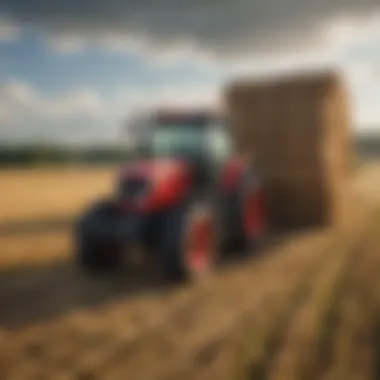
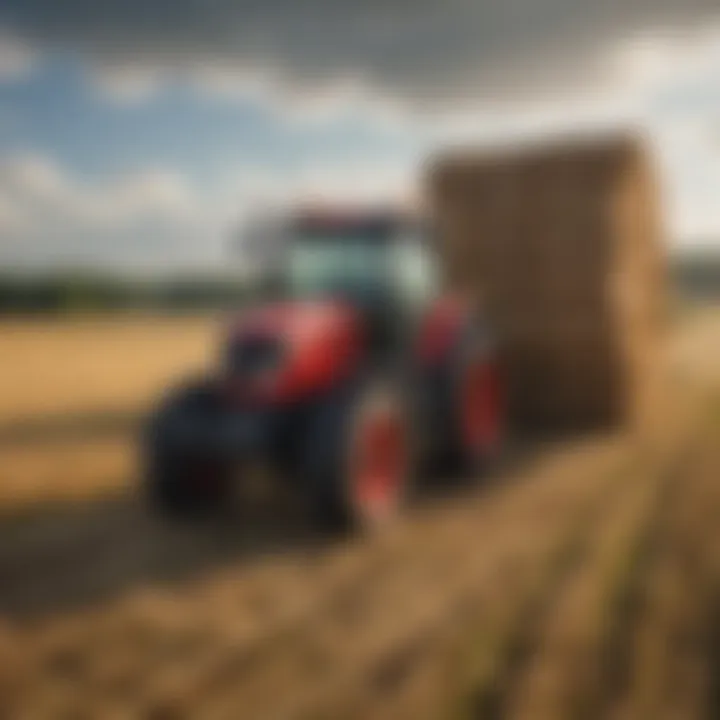
Proper maintenance and care of stabilizer hay bale spears can prolong their lifespan and improve operational reliability. Here are essential practices:
- Routine Inspections: Regularly check the spear for signs of wear, especially at the tips and weld points. Early detection of issues can prevent more serious problems down the line.
- Cleaning After Use: After each use, though it may feel tedious, take time to clean the spears. Hay residue can cause rust and clogs that affect performance over time. Using a simple brush can go a long way in maintaining the equipment.
- Lubrication: Moving parts of hay bale spears need adequate lubrication. Use appropriate lubricants for any joints to ensure they move smoothly and do not become stiff, which can lead to premature wear.
- Storage Conditions: Store the spears in a dry area to prevent corrosion. If possible, keep them covered to protect from the elements, which can degrade materials over time.
"Investing a little time in maintenance can save you a lot of money later on. Proper care often makes the difference between a tool's longevity and early replacement."
Implementing these operational best practices not only aids in the effective use of stabilizer hay bale spears but also signifies a commitment to quality in agricultural practices. In turn, this could resonate throughout the farming operation, enhancing not just productivity, but also workplace safety and equipment durability.
Safety Considerations in Hay Handling
In the world of hay production and handling, safety is no small matter. It’s a bustling farm life where mishaps can occur if proper precautions aren't taken. The integration of stabilizer hay bale spears not only enhances operational efficiency but contributes directly to a safer working environment. When farmers are equipped with the right tools and knowledge, both employee well-being and overall productivity can see substantial improvement.
Workplace Safety Norms
Establishing a culture of safety on the farm is akin to laying a strong foundation for a house; without it, everything can crumble. There are several workplace safety norms one should adhere to:
- Regular Training: Continuous education and training sessions on hay handling techniques are crucial. And it’s not just about knowing how to use the spear, but also understanding the risks involved in hay handling.
- Machine Inspections: Routine checks of the stabilizer hay bale spears and other equipment ensure they are in good working condition. Any worn-out parts can lead to accidents, so keeping a close eye is imperative.
- Clear Communication: Keeping communication lines open among team members reduces the likelihood of accidents. Using hand signals or radios can help in noisy environments where a shout may go unheard.
Implementing these norms can dramatically reduce workplace injuries. It’s only when everyone on the team is familiar with safety protocols that they can function seamlessly.
Personal Protective Equipment
The right gear can make a world of difference. When dealing with heavy machinery and bales of hay, having personal protective equipment (PPE) is non-negotiable. Here’s a list of essential PPE:
- Gloves: Strong gloves protect hands from cuts and abrasions while handling rough hay bale surfaces.
- Steel-Toed Boots: These provide foot protection against heavy bales that might drop, ensuring toes are not crushed.
- Safety Glasses: When maneuvering hay, dust and debris can fly; protective eyewear helps shield eyes from irritants.
"Safety isn't just a priority; it’s a culture. On the farm, equipment may get dirty, but our safety practices should always be spotless."
Investing in proper PPE not only keeps workers safe but fosters a mindset that values health and well-being. It’s about more than just compliance—it's about creating an environment where safety is ingrained into daily operations.
In summary, when safety considerations in hay handling receive their due attention, everyone benefits. Modern spears provide an edge in this aspect, complementing a farm's safety standards. A culture of safety along with the right equipment set the stage for success in the ever-evolving agricultural landscape.
Technological Advancements in Spear Design
The continual evolution of farming equipment has a profound impact on the efficacy of agricultural practices. When considering stabilizer hay bale spears, technological advancements are not merely enhancements; they represent a shift towards more sustainable and efficient farming methods. These innovations facilitate the handling, transporting, and storing of hay bales with greater simplicity and effectiveness, directly benefiting farmers in their day-to-day operations.
Smart Technology Integration
In recent times, smart technology has found its way into the realm of agricultural tools, including hay bale spears. The integration of sensors and automation can significantly streamline operations, allowing farmers to monitor their equipment's performance in real-time. For instance, some modern spears are equipped with scales that provide accurate weight measurements of the hay bales being moved. This feature can help ensure compliance with weight limits on roads, reducing the risk of tickets or accidents due to overloaded vehicles.
Moreover, certain models now come with connectivity options, enabling farmers to analyze data through dedicated apps. Such applications can present critical insights into usage patterns, highlighting when maintenance is due or if the spear is being utilized efficiently. Keeping the right tools in top condition becomes more straightforward, reducing downtime, which is vital during the busy harvesting seasons.
"The future of agricultural technology hinges on the ability to gather and analyze data efficiently; this is where smart technology shines."
Furthermore, the use of GPS through these smart spears aids in mapping storage locations and optimizing the layout of hay storage areas. Farmers can save a substantial amount of time and effort, ensuring hay is organized and accessible.
Innovative Materials
Equally important in the realm of technological advancements is the development of innovative materials used in the construction of hay bale spears. Traditional spears, often made from heavier metals, can be cumbersome and lead to extra strain on equipment and operators alike. However, advancements now favor lighter yet durable materials, such as high-tensile steel and composite materials. These innovations not only reduce the overall weight of the spears but also enhance their strength and longevity.
For instance, using lighter materials can assist farmers in maneuvering the spears effortlessly, thereby increasing efficiency in their operations. A lighter spear results in reduced fuel consumption, as machinery doesn't have to exert as much effort to lift and transport hay bales. Consequently, not only are costs reduced, but wear and tear on equipment can also be lessened, extending equipment lifespan.
Additionally, the refinement of coatings and finishes can result in greater resistance to corrosion and wear, which is essential when dealing with an environment like a wet hay field or a humid storage facility.
These advancements ultimately contribute to the overarching goals of modern agriculture—sustainability and productivity. As each farmer navigates the complexities of today's farming landscape, embracing these technological advancements in spear design aids in achieving greater stability in operations and reducing the overall ecological footprint of farming activities.
Environmental Considerations
The environmental aspect of agricultural practices is becoming increasingly significant as we move toward sustainable farming. Stabilizer hay bale spears play a pivotal role in this context, offering solutions that align with ecological mindfulness. By focusing on sustainability and waste reduction, these tools help create a more eco-friendly agricultural sector.
Farmers are often at the frontline of environmental impact. Using robust, well-designed equipment like hay bale spears not only enhances operational efficiency but also minimizes harm to the land. As these spears are designed to reduce soil compaction when handling hay, they directly contribute to maintaining soil health, which is vital for long-term agricultural productivity.
Furthermore, with the rising concerns over climate change and resource depletion, using spears constructed from sustainable materials can significantly decrease the carbon footprint of farming equipment. Investing in durable and recyclable options means less waste and enhanced longevity, leading to less frequent replacements and lower overall material usage.


"Agriculture is not just about growing food; it's also about nurturing the land for future generations."
Sustainability in Equipment Use
Sustainability in the use of stabilizer hay bale spears revolves around selecting high-quality, durable materials that can withstand the rigors of agricultural work without needing replacement. For instance, spears made from high-tensile steel can offer greater longevity due to their resistance to bending and breakage, thus reducing the need for frequent repairs or replacements.
Moreover, these spears typically integrate functionality that allows for multi-purpose use. For farmers who are tight on space and resources, having a tool that can effectively carry out various tasks means less equipment clutter and reduces the environmental burden of manufacturing additional tools.
In terms of end-of-life considerations, it is essential to think about how these tools can be recycled. By promoting the use of materials that can be repurposed, farmers can ensure they are keeping waste to a minimum and engaging in a restorative farming practice.
Reducing Waste in Hay Production
The production and handling of hay can lead to significant waste if not managed properly. Stabilizer hay bale spears directly mitigate some of these issues by allowing for precise loading and unloading processes, thus minimizing spoilage or damage to hay bales during transportation.
In addition, with improved handling efficiency, farmers can optimize the use of their resources. For instance, bale spears prevent broken bales from scattering and becoming unusable. This means that more of what is produced can be effectively utilized, leading to less waste overall.
Another consideration is the stackability of hay bales facilitated by these spears. Efficient stacking means that storage space is used wisely, and hay remains in good condition for longer without unnecessary exposure to moisture or pests.
Comparative Analysis with Traditional Methods
In the ever-evolving landscape of modern agriculture, the comparison between stabilizer hay bale spears and traditional hay handling methods bears significance not just in functionality but also in efficiency and safety. Farmers often find themselves at a crossroads, deciding whether to stick with tried and true techniques or embrace innovative tools that could streamline their operations. The traditional methods, while familiar, come with a host of challenges that hamper productivity and increase physical strain on operators.
One prominent area of consideration is efficiency. Traditional bale handling often involves a lot of manual labor. Workers may rely on forklifts or even their hands to lift and transport hay bales. This approach, while it has worked for years, can lead to inefficiencies, especially when handling large quantities in a limited timeframe. In contrast, stabilizer hay bale spears can dramatically speed up the process. They allow for the effortless lifting and moving of multiple bales at once, utilizing tractor-mounted rigs that require lower physical effort.
Furthermore, the versatility of stabilizer hay bale spears makes them an attractive option. They can be employed in diverse situations like loading, unloading, and transporting, providing far greater adaptability compared to traditional manual methods. This integration of a single tool into multiple roles simplifies operations and reduces the time spent shifting from one task to another.
Benefits and considerations include:
- Time Savings: Spear-equipped tractors can complete tasks in a fraction of the time.
- Labor Costs: Reduced need for manpower lessens labor expenses.
- Safety: Lifting large, hefty bales manually poses risks. Spear usage helps mitigate injuries by relying on machinery.
- Operational Flexibility: Adapt easily across various farm operations, from hay transport to feed storage.
"Adopting advanced tools like stabilizer hay bale spears doesn't just change how we handle hay; it revolutionizes our entire workflow," says an experienced farmer.
While these advantages are compelling, transitioning to a mechanized solution is not without its considerations. The cost of acquiring these implements is higher than sticking with traditional methods. Farmers must weigh their initial investment against potential long-term gains. Additionally, maintenance of these more complex machines requires knowledge and skill that farmers must manage.
Effectiveness in Different Scenarios
When evaluating the effectiveness of stabilizer hay bale spears compared to traditional methods, context matters. In smaller operations, where the volume of hay isn't substantial, one might argue that the traditional methods suffice. However, in larger farming operations, the need for efficiency cannot be overstated.
For example, a dairy farm demanding hay storage for winter feed can see dramatic benefits. With multiple bales to handle daily, the quick adaptability of a spear enables farmers to maneuver through the workload with ease. In contrast, a smaller operation might still depend on manual handling, which leads to prolonged labor hours and risk of accidents. The context of the farm size and hay volume dictates how method effectiveness is perceived.
User Experiences and Testimonials
Real-life experiences and testimonials provide insight into how practical these comparisons are.
A Midwestern farmer shares,
"Switching to stabilizer hay bale spears cut our hay-moving time in half. I can lift and stack bales without breaking a sweat. It’s a game changer, especially during the fall when harvest is in full swing."
User experiences span the spectrum, but the consensus leans heavily towards a positive reception of these tools. Many users report reduced fatigue and enhanced productivity, citing specific instances where transitioning to spear technology allowed them to accomplish in hours what previously took days.
Others note the improvement in safety, as operations become less physically demanding. Insurance claims related to hay handling accidents have noticeably declined among users of spear technology, emphasizing that greater machinery support leads to a safer workplace.
In summary, the comparative analysis between stabilizer hay bale spears and traditional handling techniques presents a nuanced landscape. Each method has its strengths, but the trend leans towards adopting innovative solutions that enhance efficiency and protect workers. This shift is shaping the future of how hay is handled on farms, and with the right resources and knowledge, farmers can make informed decisions tailored to their unique operations.
Culmination and Future Perspectives
In wrapping up the discourse on stabilizer hay bale spears, it becomes starkly clear that these implements play an essential role in modern agriculture. They not only enhance the efficiency of hay handling but also contribute significantly to the overall productivity of farming operations. As agricultural practices continue to evolve, the relevance of stabilizer hay bale spears cannot be overstated. Their capacity to adapt to various applications - from loading to transporting and storing hay - makes them an invaluable asset.
Summary of Key Insights
To summarize, the importance of stabilizer hay bale spears manifests in several key insights:
- Efficiency: These tools streamline hay handling, which reduces operational time and labor costs.
- Safety: By enhancing load stability, they mitigate risks of accidents and injuries in the workplace.
- Economic Benefits: The investment in this equipment often pays off through reduced waste and enhanced productivity.
- Technological Innovations: New designs, featuring smart technology and advanced materials, provide farmers with modern solutions to age-old challenges.
As these insights highlight, the dirction of agricultural technology is steadily tilting towards improving not just equipment but the entire farming process itself. Using stabilizer hay bale spears can revamp how hay is managed from field to barn.
Future Trends in Equipment Development
Looking ahead, several trends are likely to shape future developments in stabilizer hay bale spears:
- Smart Integration: We may see increased incorporation of sensors and data analytics in spear designs. This could optimize the spears’ operation based on real-time conditions, ultimately enhancing performance.
- Sustainable Materials: As the agricultural sector embraces sustainability, there might be a shift towards using recyclable and biodegradable materials in spear construction. This would not only reduce the environmental footprint but also align with broader agricultural sustainability goals.
- Customization: Future designs could focus more on customization, allowing farmers to tailor their equipment to specific needs, whether for different bale sizes or terrain types.
- Collaboration with Robotics and Automation: The future could bring the merging of stabilizer hay bale spears with robotic agricultural solutions, facilitating bales' handling with greater precision and minimal human intervention.



